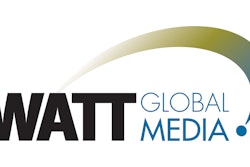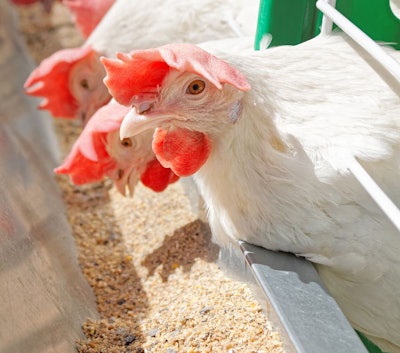
Annual survey reveals how macro trends will influence poultry production and feed formulations this year
WATT Global Media’s annual Poultry Nutrition & Feed Survey offers insight into the trends impacting the poultry industry worldwide, and reveals how poultry producers, nutritionists and feed manufacturers are adapting to new and evergreen production challenges.
In 2023, Russia’s invasion of Ukraine, high inflation, recession fears, and animal diseases have made survey respondents slightly less optimistic than they were in 2022. While 44% of respondents believe their company’s profitability will improve in 2023, 30% feel it will remain flat and 26% predict it will deteriorate. Regardless, 37% of survey respondents forecast increased feed production in the next 12 months and 36% think it will stay the same as their 2022 volume.
The 2023 edition of the global survey includes feedback from 328 respondents, with more than half of those responding serving as nutritionists, consultants and veterinarians; 16% work in live production management or own a poultry farm.

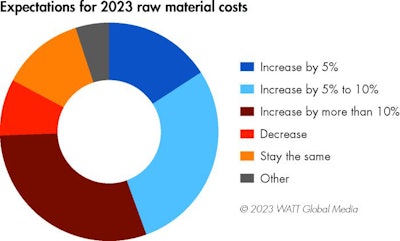
2023 profitability challenged by HPAI, Ukraine
In 2023, respondents will be grappling with the effects of two crises not reflected in last year’s report: the war in Ukraine and the devastating highly pathogenic avian influenza (HPAI) outbreak.
According to 84% of respondents, HPAI has greatly or moderately decreased their feed production and will continue to challenge their poultry operations and biosecurity protocols into 2023.
One year after Russia’s invasion of Ukraine, 88% note that the conflict has impacted their business, with 51% stating that it has had very significant effects by further heightening market volatility and economic uncertainty.
When asked to weigh in on the primary challenges facing their business, 86% cited raw material costs as their No. 1 challenge — with at least 30% bracing for increases of more than 10%. Twenty-nine percent of survey respondents anticipate their grain costs will rise by between 5% to 10%; 15% of respondents anticipate costs increasing by 5% or less. Meanwhile, 12% are optimistic they will stay the same as 2022, and only 8% believe their ingredient costs will decrease.
High energy and transportation costs (75%) ranked among producers’ top concerns. Respondents also believe rising feed additive and micro-ingredient prices (61%) and availability (60%) will further increase their feed costs. Sixty-four percent report tight or deteriorated margins causing concern.
Despite high interest rates, some poultry and feed companies are making capital investments in 2023. Thirty-five percent of survey respondents report their company is investing in biosecurity; 30% plan to upgrade their feed mills and another 30% will purchase new manufacturing or processing equipment this year. Eleven percent of respondents share that their company will be undertaking greenfield facility construction. However, 28% report no major or notable financial investments on the horizon this year.
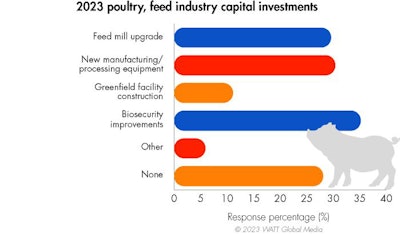
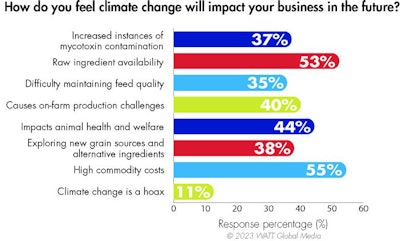
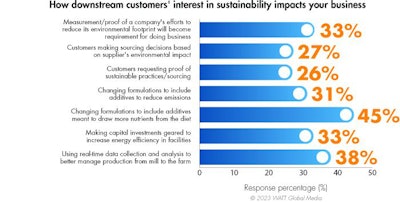
Climate change, sustainability influence feed production
Sustainability will influence poultry and feed producers in 2023. For example, 45% of survey respondents say they have changed their formulations to include additives that draw more nutrients from rations and 31% added emission-reducing feed additives to their feeding programs.
Twenty-six percent of respondents report that their downstream customers have requested proof of sustainable practices and sourcing, and 27% report these customers are making decisions based on the perceived environmental impact of their suppliers. Thirty-three percent of respondents believe that in the future companies will be required to provide proof and proper documentation of its efforts to reduce its environmental footprint, which will become a requirement for doing business.
Companies are also investing in equipment to improve energy efficiency in their facilities (33%) and utilizing real-time data collection and analysis to better manage production (38%).
In 2023, most survey respondents acknowledge climate change and its impacts on agriculture. As it relates to feed production, in the future, survey respondents believe climate change will be responsible for impacting raw material availability (53%), high commodity costs (55%), increased instances of mycotoxin contamination (37%) and difficulty maintaining feed quality (35%). Thirty-eight percent of respondents will be exploring new grain sources and alternative ingredients.
Poultry producers feel it will impact animal health and welfare (44%) and pose on-farm production challenges (40%).
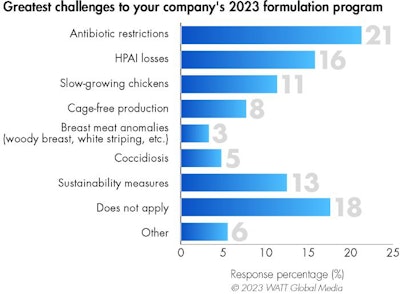


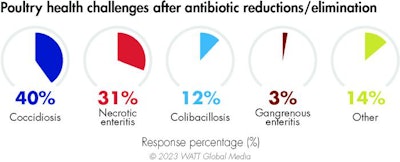
Antibiotic reduction, elimination
Asked to identify which poultry production trends will have the greatest impact on their feed costs and formulation programs, 21% of respondents cited antibiotic restrictions as their greatest production challenge in 2023, Next, 16% noted HPAI losses, 13% sustainability and 11% slow-growing chicken production.
Ninety percent of 2023 survey participants report having some degree of antibiotic-free (ABF) production in their poultry operations — with 34% stating that 100% of their production is ABF.
The greatest challenges respondents cite in the transition to ABF poultry production lie in the inconsistent results they have experienced with feed additives alternatives (41%), the cost of feed additives (34%), the losses related to the elimination of antibiotic growth promoters (AGP) (32%) and the learning curve for nutritionists (23%).
Respondents cite increased coccidiosis (40%) and necrotic enteritis (31%) in their poultry operations correlating with antibiotic reductions or elimination.
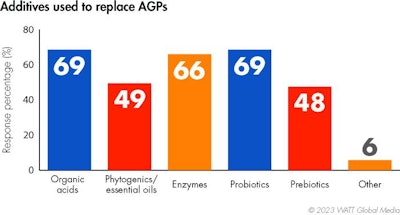
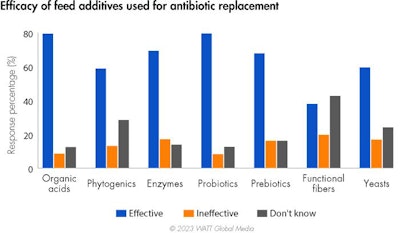

Weighing in on AGP alternatives
Seventy-one percent of respondents report that their company is actively exploring, testing or using feed additives as antibiotic alternatives or replacements.
To regain the production gains AGPs provided, survey respondents have incorporated different feed additives into their rations to bridge the gap. Probiotics (69%) and organic acids (69%) tied as the most popular AGP alternatives, followed by enzymes (66%), phytogenic feed additives (49%) and prebiotics (48%).
Respondents report probiotics (80%), organic acids (80%) and enzymes (69%) to be the most effective feed additives alternatives to antibiotics. The efficacy of prebiotics (67%) and yeasts (59%) ranked fourth and fifth respectively. Fifty-eight percent of respondents believe phytogenic feed additives and essential oils are effective, but 28% didn’t comment on the efficacy of the category. Nearly half of respondents did not know how to leverage functional fibers (43%) in ABF diets.
Comparing their outlook for 2023 inclusions against 2022, respondents will increase their use of probiotics (61%), prebiotics (55%) and essential oils (48%) this year. Twenty-six percent will decrease their use of subtherapeutic and therapeutic (25%) antibiotics in their poultry operations.
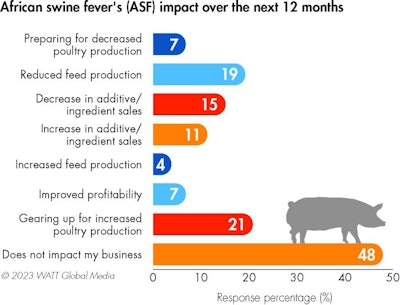
ASF’s influence on feed industry
African swine fever (ASF) virus outbreaks continue to challenge pork producers throughout Asia and Eastern Europe. Of survey respondents, 21% believe the disease will spur an increase in poultry production. Conversely, 15% believe it will decrease their additive and ingredient sales and others (19%) believe it will lead to reduced feed production. ASF will not impact the businesses of 48% of respondents.
Survey highlights
The 2023 Poultry Nutrition & Feed Survey includes input from 328 poultry and feed industry stakeholders worldwide. This WATT Global Media special report seeks to identify the feeding and external trends shaping these sectors during the past 12 months; it was conducted in English and Spanish.
Participants included:
Nutritionists: 28%
Veterinarians: 13.5%
Consultants: 13%
Quality control, purchasing agent, other: 11.5%
Poultry farm owner/grower: 11%
Marketing and sales: 9%
Live production management: 5%
Feed mill/plant operations: 5%
General administration: 4%
Responses from:
United States/Canada: 27%
Mexico/Latin America: 25%
Asia/Pacific: 21%
Europe: 13%
Africa: 12%
Middle East: 2%
Sectors:
Consultant/veterinarian/nutritionist: 43%
Feed manufacturing: 13%
Manufacturing/distributing feed additives: 10.5%
Egg production: 9%
Broiler production: 8%
Breeder farm/hatchery: 4.5%
Premix manufacturing: 3%
Turkey/duck production: 2%
Poultry processing: 1%
Other: 6%


